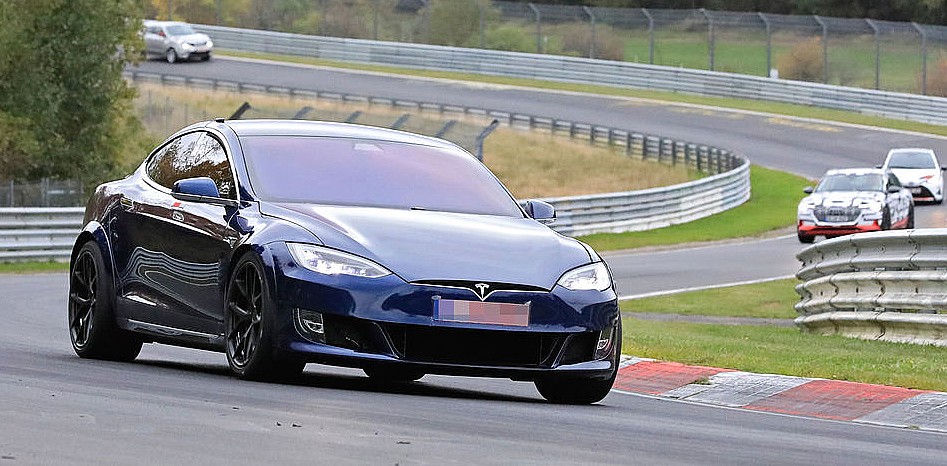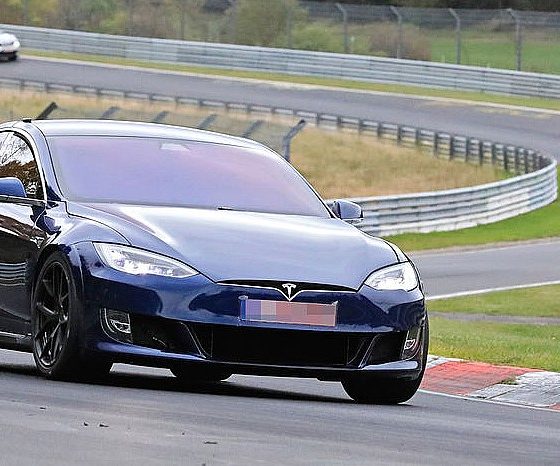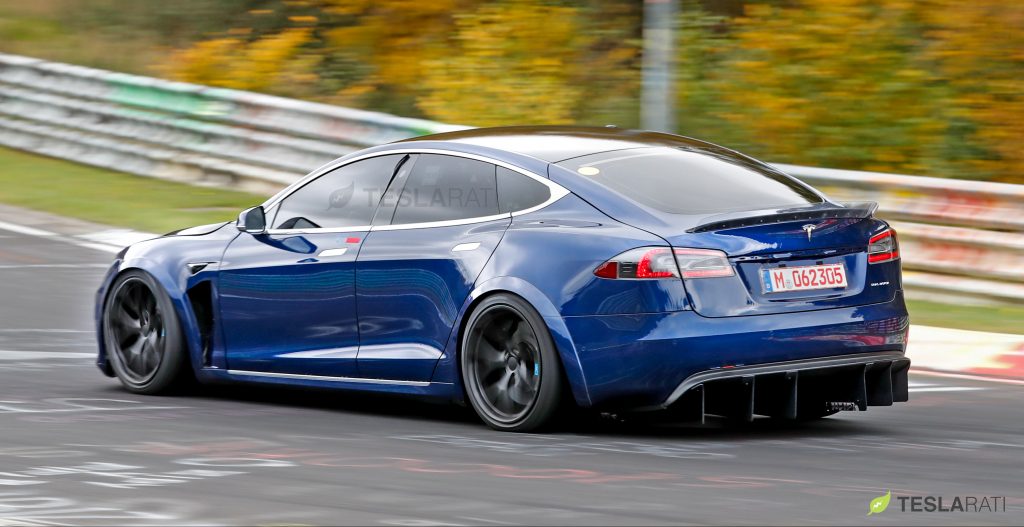

News
Tesla Model S Plaid sets new record at the Nürburgring in final run for the year
Recent reports from German motoring publication Auto Motor und Sport have revealed that the blue Tesla Model S Plaid prototype has broken the company’s previous unofficial record on the Nurburgring, with the vehicle completing a lap around the track in 7:13. The Model S was able to accomplish this feat not just once, but twice.
What is even more impressive was that Tesla accomplished this feat with a unit that previously completed a 7:40 lap around the Nurburgring in September. During that time, Tesla was able to finish a reported hand-stopped lap of 7:23, though it used its red Model S Plaid prototype, a vehicle that unfortunately crashed during a hot lap in recent weeks. Fortunately, the red Model S’ driver, Andreas Simonsen, was unharmed during the accident.
As noted by the publication, the blue Model S Plaid prototype was driven around the Nurburgring by Nordschleife expert and racing driver Thomas Mutsch. For its record-setting runs, the Model S was equipped with its large rear diffuser and a small rear spoiler. A large spoiler spotted by photographers previously had reportedly been removed by Tesla after a short session around the track. The vehicle was equipped with Michelin Pilot Sport Cup 2 Cup R sports tires for its record-setting runs as well.

That being said, the blue Plaid Tesla Model S’ two 7:13 records are still unofficial lap times for the vehicle. Thus, for now at least, the electric car maker simply has the knowledge that its upgraded Tesla Model S is capable of beating the already-stellar 7:23 record it set for itself during its first excursion into the track over a month ago. Nevertheless, the blue Plaid Model S’ recent unofficial record is still 8 seconds shy of the 7:05 estimate that Tesla announced on Twitter when it left the Nurburgring for the first time in late September.
Auto Motor und Sport noted that the Tesla team has departed the iconic German racetrack for now, with the team likely not coming back this year. The two vehicles used for the test — the red Model S Plaid that crashed, as well as the blue Plaid unit that set the 7:13 record — are reportedly being sent home to the United States. With this in mind, it appears that Tesla might be preparing to return to the Nurburgring with new Model S Plaid units next year, perhaps finally ready to set its own official lap record.

What is particularly interesting is that Tesla’s new unofficial lap time around the Nurburgring is already 29 seconds faster than the Porsche Taycan Turbo prototype that set an unofficial 7:42 record of its own around the German racetrack prior to the all-electric sports car’s official release. Considering that the blue Model S Plaid reportedly left the track last September with a 7:40 lap, the vehicle’s current 7:13 time is quite a notable improvement.
After all, it appears that Tesla was testing two Plaid Model S variants in the Nurburgring this time around. Based on the initial track times of the two prototypes, it appears that Tesla was actually benchmarking the red and blue Model S against each other. And between the two vehicles, it almost seemed like the blue Plaid Model S was the more conservatively-specced vehicle. Either way, Tesla’s return next year would likely be incredibly exciting, as the company would likely come back with a vehicle that will be very close to the actual production Plaid Model S that’s set for release next year.
At 7:13, Tesla’s Model S Plaid prototype has already exceeded the lap time of the 2018 Jaguar XE SV Project 8, which completed the Nurburgring in a blazing-fast 7:21. That’s the fastest four-door vehicle around the Nurburgring to date, not counting the prototype monster that Porsche brought over to the track recently, the Panamera “Lion” project, which reportedly completed a 7:11 lap. Quite interestingly, it appears that no laps have been done by Porsche with the Taycan Turbo S as of yet.

Elon Musk
Elon Musk and Tesla AI Director share insights after empty driver seat Robotaxi rides
The executives’ unoccupied tests hint at the rapid progress of Tesla’s unsupervised Robotaxi efforts.

Tesla CEO Elon Musk and AI Director Ashok Elluswamy celebrated Christmas Eve by sharing personal experiences with Robotaxi vehicles that had no safety monitor or occupant in the driver’s seat. Musk described the system’s “perfect driving” around Austin, while Elluswamy posted video from the back seat, calling it “an amazing experience.”
The executives’ unoccupied tests hint at the rapid progress of Tesla’s unsupervised Robotaxi efforts.
Elon and Ashok’s firsthand Robotaxi insights
Prior to Musk and the Tesla AI Director’s posts, sightings of unmanned Teslas navigating public roads were widely shared on social media. One such vehicle was spotted in Austin, Texas, which Elon Musk acknowleged by stating that “Testing is underway with no occupants in the car.”
Based on his Christmas Eve post, Musk seemed to have tested an unmanned Tesla himself. “A Tesla with no safety monitor in the car and me sitting in the passenger seat took me all around Austin on Sunday with perfect driving,” Musk wrote in his post.
Elluswamy responded with a 2-minute video showing himself in the rear of an unmanned Tesla. The video featured the vehicle’s empty front seats, as well as its smooth handling through real-world traffic. He captioned his video with the words, “It’s an amazing experience!”
Towards Unsupervised operations
During an xAI Hackathon earlier this month, Elon Musk mentioned that Tesla owed be removing Safety Monitors from its Robotaxis in Austin in just three weeks. “Unsupervised is pretty much solved at this point. So there will be Tesla Robotaxis operating in Austin with no one in them. Not even anyone in the passenger seat in about three weeks,” he said. Musk echoed similar estimates at the 2025 Annual Shareholder Meeting and the Q3 2025 earnings call.
Considering the insights that were posted Musk and Elluswamy, it does appear that Tesla is working hard towards operating its Robotaxis with no safety monitors. This is quite impressive considering that the service was launched just earlier this year.
Elon Musk
Starlink passes 9 million active customers just weeks after hitting 8 million
The milestone highlights the accelerating growth of Starlink, which has now been adding over 20,000 new users per day.

SpaceX’s Starlink satellite internet service has continued its rapid global expansion, surpassing 9 million active customers just weeks after crossing the 8 million mark.
The milestone highlights the accelerating growth of Starlink, which has now been adding over 20,000 new users per day.
9 million customers
In a post on X, SpaceX stated that Starlink now serves over 9 million active users across 155 countries, territories, and markets. The company reached 8 million customers in early November, meaning it added roughly 1 million subscribers in under seven weeks, or about 21,275 new users on average per day.
“Starlink is connecting more than 9M active customers with high-speed internet across 155 countries, territories, and many other markets,” Starlink wrote in a post on its official X account. SpaceX President Gwynne Shotwell also celebrated the milestone on X. “A huge thank you to all of our customers and congrats to the Starlink team for such an incredible product,” she wrote.
That growth rate reflects both rising demand for broadband in underserved regions and Starlink’s expanding satellite constellation, which now includes more than 9,000 low-Earth-orbit satellites designed to deliver high-speed, low-latency internet worldwide.
Starlink’s momentum
Starlink’s momentum has been building up. SpaceX reported 4.6 million Starlink customers in December 2024, followed by 7 million by August 2025, and 8 million customers in November. Independent data also suggests Starlink usage is rising sharply, with Cloudflare reporting that global web traffic from Starlink users more than doubled in 2025, as noted in an Insider report.
Starlink’s momentum is increasingly tied to SpaceX’s broader financial outlook. Elon Musk has said the satellite network is “by far” the company’s largest revenue driver, and reports suggest SpaceX may be positioning itself for an initial public offering as soon as next year, with valuations estimated as high as $1.5 trillion. Musk has also suggested in the past that Starlink could have its own IPO in the future.
News
NVIDIA Director of Robotics: Tesla FSD v14 is the first AI to pass the “Physical Turing Test”
After testing FSD v14, Fan stated that his experience with FSD felt magical at first, but it soon started to feel like a routine.

NVIDIA Director of Robotics Jim Fan has praised Tesla’s Full Self-Driving (Supervised) v14 as the first AI to pass what he described as a “Physical Turing Test.”
After testing FSD v14, Fan stated that his experience with FSD felt magical at first, but it soon started to feel like a routine. And just like smartphones today, removing it now would “actively hurt.”
Jim Fan’s hands-on FSD v14 impressions
Fan, a leading researcher in embodied AI who is currently solving Physical AI at NVIDIA and spearheading the company’s Project GR00T initiative, noted that he actually was late to the Tesla game. He was, however, one of the first to try out FSD v14.
“I was very late to own a Tesla but among the earliest to try out FSD v14. It’s perhaps the first time I experience an AI that passes the Physical Turing Test: after a long day at work, you press a button, lay back, and couldn’t tell if a neural net or a human drove you home,” Fan wrote in a post on X.
Fan added: “Despite knowing exactly how robot learning works, I still find it magical watching the steering wheel turn by itself. First it feels surreal, next it becomes routine. Then, like the smartphone, taking it away actively hurts. This is how humanity gets rewired and glued to god-like technologies.”
The Physical Turing Test
The original Turing Test was conceived by Alan Turing in 1950, and it was aimed at determining if a machine could exhibit behavior that is equivalent to or indistinguishable from a human. By focusing on text-based conversations, the original Turing Test set a high bar for natural language processing and machine learning.
This test has been passed by today’s large language models. However, the capability to converse in a humanlike manner is a completely different challenge from performing real-world problem-solving or physical interactions. Thus, Fan introduced the Physical Turing Test, which challenges AI systems to demonstrate intelligence through physical actions.
Based on Fan’s comments, Tesla has demonstrated these intelligent physical actions with FSD v14. Elon Musk agreed with the NVIDIA executive, stating in a post on X that with FSD v14, “you can sense the sentience maturing.” Musk also praised Tesla AI, calling it the best “real-world AI” today.








